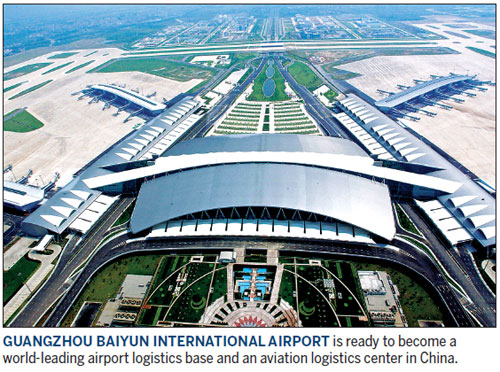Historical commerce hub expands international aviation links
Guangzhou, capital city of Guangdong province, was announced as the host city for the 2018 World Route Development Forum.
The 2017 forum took place in Barcelona last week. During the flag handing over ceremony, representatives of Guangdong Airport Authority accepted the forum cup and flag.
Established in 1995 by UBM Aviation, the World Route Development Forum is regarded as the "World Expo" for the global aviation industry. It is a worldwide event for airlines, airports, government agencies and tourism agencies.
To make full use of this opportunity to promote Guangzhou - also the host city of the Fortune Global Forum 2017 - the Guangdong Airport Authority sought to agree deals with international aviation companies and expand its global reach.

Guangzhou, as a historical commercial hub in South China, has been building itself into an international flight center, according to local officials.
China Southern Airlines and 9Air are both based in Guangzhou. An aviation industrial cluster has taken shape in the area surrounding Guangzhou Baiyun International Airport, providing a bonded area, airport logistics and aeronautical maintenance services.
At Guangzhou Baiyun International Airport - the third-largest Chinese airport in terms of cargo throughput - a new terminal is scheduled to open by February 2018.
In recent years, the airport has been playing a significant role in connecting China with countries and regions in Asia-Pacific region, Oceania and Africa. More routes connecting Europe and the Americas are also in the pipeline.
By June, routes from the airport covered 219 worldwide destinations. There are 77 airline companies running operations from the airport, including 50 from foreign countries.
By 2025, the cargo throughput of Baiyun airport is expected to reach 3 million metric tons, marking its attempt to become a world-leading airport logistics base and an aviation logistics center in China.
The total investment in the city's international aviation expansion has reached 10.35 billion yuan.
The 13 new international routes recently established have increased the airport's passenger throughput by 10.8 percent.
In addition to the flight routes, Guangzhou is also transforming itself into an international center for shipping and technological innovation.
According to statistics provided by the Guangzhou Municipal Development and Reform Commission, a total of 34 international shipping hub projects attracted 5.5 billion yuan in investment in the first half of 2017.
The construction of Nansha Port's near-sea area recently commenced, with eight new foreign trade routes launching, driving container cargo growth of 11.8 percent year-on-year.
A total of 13.78 billion yuan ($2.08 billion) in investment has been pumped into the city's overall push to become an international technology-innovation center.
Baiyun International Airport Fast Facts
From 2012 to 2016, annual takeoffs and landings at Guangzhou Baiyun International Airport increased from 373,000 to 435,000.
Annual passenger throughput increased from 48.31 million passengers to 59.78 million over the same four-year period.
Annual cargo throughput increased from 1.25 million to 1.65 million metric tons between 2012 and 2016. The airport ranked No 3 among its national peers for cargo throughput.
By 2025, cargo throughput will reach 3 million tons annually, making it one of China's leading aviation logistics centers and one of the world's leading airport logistics bases.
The Baiyun airport network covered 219 destinations worldwide as of June 2017, with 86 international and regional destinations, 77 airlines, including 50 foreign and regional airlines, operating out of the airport. There were 122 million outbound Chinese tourists in 2016, with Guangzhou representing a top "door" to the outside world.
As part of these development efforts, Guangdong province has sped up the formation of its"5+4" airport pattern, as well as boosting transport volumes, cargo throughput, networks and the industrial surrounding Baiyun airport.
The airport has become the first port hub for travel between China, Southeast Asian and Oceania. Its global and regional network is increasingly expanding to cover a growing expanse of Europe, the United States and beyond.


















